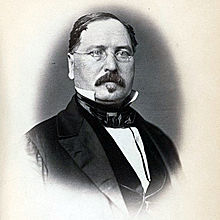In the early 19th century, Prince George's County felt that having a better connection to Washington DC and Southern Maryland was essential to its economic success. From Baltimore north, a continuous line of railroads stretched through Philadelphia, New York, Boston, and Portland. From the Potomac River south, another long line of railroads ran through Richmond, Wilmington, Augusta and on to New Orleans. The missing link? A connection between Baltimore and the Potomac River. The answer, according to my Bowie cousins, was a new railroad line.
My Bowie cousins--Walter William Weems Bowie, Thomas Fielder Bowie, Robert Bowie, William Duckett Bowie, and Oden Bowie--lobbied extensively for this project and eventually succeeded in 1853 when the Maryland legislature chartered the Baltimore and Potomac Railroad Company, authorizing it to construct a line from Baltimore via Marlboro in Prince George's County and Port Tobacco in Charles County to a point on the Potomac River in St. Mary's County, the southernmost in the state. Importantly, the charter also allowed the construction of branches to the line up to 20 miles in length.
As the map below shows, this last provision allowed the railroad to build a line to Washington DC, which is what the promoters wanted all along.
William Walter Weems "Three W" Bowie (1814-1891), a prominent planter and merchant in Prince George's County, was respected throughout Southern Maryland for his agricultural expertise as well as his talent as a raconteur who could set a room roaring with laughter. (He and his wife, Adeline Snowden, were also the parents of Confederate spy Wat Bowie, about whom I have previously written.)
Under his nom de plume of A Patuxent Planter, WWW wrote extensively about issues such as tobacco culture and rebuilding worn out land. It was at least partly his devotion to agriculture that led him to argue in The Planter's Advocate for the efficiency of having rail transport for Prince George's produce instead of the then-current method of Patuxent rivercraft.
WWW's cousin, Robert Bowie (1804-1881) was likewise very interested in agriculture. He was active in agricultural societies, helped organize the Maryland Jockey Club, and through personal appeals gained enough subscriptions to erect the Maryland Agricultural College. Like his cousin, he did not seek political office, but used his influence among the planters of Prince George's County to lobby energetically for the creation of a rail line through their county."But only let a railroad be built through the country . . . connecting with Baltimore, . . . it will then take an exceedingly short time for our produce to reach the market: the road will, unlike the river, be always open and always ready for the transmission of produce. . . . Above all, we earnestly and anxiously look forward to the building of this road because it will infuse a spirit of life and animation in our country. It will arouse public spirit. It will foster enterprise and activity."
WWW's eloquence and Robert's zeal certainly helped make the case for the railroad, but it also needed the political skills of the other Bowie cousins to seal the deal.
Robert Bowie's brother, General Thomas Fielder Bowie (1808-1869), educated at Charlotte Hall and Union College, was admitted to the bar at the age of 21. A man of commanding presence and a powerful voice, like his cousin, he was passionately interested in agriculture, including race horses and cattle, and served for years as the secretary of the State Agricultural Society. He was elected three times to the State Legislature and elected to Congress in 1854. Thomas Fielder Bowie used his political position to lobby for the proposed railroad. When the Baltimore and Potomac Railroad was finally enacted in 1853, both Thomas and WWW were charter members.
 |
| Washington Station |
The Baltimore and Potomac opened a substantial station in Washington at the present site of the west building of the National Gallery of Art. It was in this station (since demolished) that President James Garfield was assassinated in 1881.
When the Washington Line opened in 1872, it branched off of the Pope's Creek Line at the town of Huntington. But by 1873, the station had been renamed Bowie in honor of Governor Oden Bowie. A few years later the entire town was renamed Bowie. After completing his workday in Baltimore, former Governor Bowie rode home on the Pope’s Creek train to Collington Station near his Fairview plantation. He insisted on sitting in his favorite seat, which was the third seat on the left in the train’s last coach car. Often he would send one of his office workers to save the seat for him until he arrived. According to his great-grandson, “Rumor had it that he diverted the railroad to Bowie so he could get home at night.”
The Baltimore and Potomac Tunnel, opened in 1873, allowed the Pennsylvania Railroad to directly connect its northern lines through Baltimore to Washington. The tunnel is still in use by Amtrak today and remains one of the worst bottlenecks in rail traffic in the Northeast. In 2021, Amtrak and Maryland announced the construction of the new Frederick Douglass Tunnel, scheduled to open in 2035.
So, next time you ride the train from Baltimore to Washington, thank the Bowie cousins for their perseverance in lobbying for the Baltimore and Potomac Railroad.
Ironically, the railroad that was so passionately argued for as a boon to agriculture actually helped to transform Southern Maryland from an agricultural economy to a commercial economy.



.jpg)


Love that rumor saying former Gov Bowie diverted the train so he could get home conveniently by train every night!
ReplyDelete